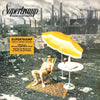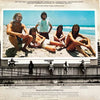



Supertramp – Crisis? What Crisis? (Half-speed Mastering)
50th Anniversay Edition
Supertramp [click here to see more vinyl featuring Supertramp]
- Rick Davies – lead and backing vocals, acoustic piano (A3, A5, B2-3), Wurlitzer piano (B2), harmonica (track 2), organ (A2-3, B1, B5), harpsichord (A4, B1, B5), synthesizers (A1,-2, A4, B1, B3-4)
- Roger Hodgson – lead and backing vocals, electric guitar (A1-3, A5 to B2, B4) 12-string guitar (A1-2, B4-5), acoustic piano (A4), Wurlitzer piano (B2), flageolet (A2), cello (B2), pump organ (B5), marimba (B1), electric sitar (A1-2)
- John Anthony Helliwell – saxophones, clarinet and bass clarinet (B2, B5), backing vocals (A3, B1-2, B5)
- Dougie Thomson – bass guitar
- Bob Siebenberg (credited as Bob C. Benberg) – drums, percussion
Orchestra and choir arrangement by Richard Hewson
Written by Rick Davies and Roger Hodgson
1 LP, standard sleeve
Original analog Master tape : YES
Heavy Press : 180g
Record color : black
Speed : 33RPM
Size : 12”
Stereo
Studio
Record Press : Pallas
Label : A&M Records
Original Label : A&M Records
Recorded Summer 1975 at A&M Studio (Hollywood), Ramport Studio (London), Scorpio Sound Studio (London)
Engineered by John Jansen & Ken Scott
Produced by Ken Scott and Supertramp
Remastered by Ken Scott, Miles Showell at Abbey Road Studios
Cover design by Fabio Nicoli, Paul Wakefield, Dick Ward
Originally released in November 1975
Reissued in August 2025
Tracks:
Side A:
- Easy Does It
- Sister Moonshine
- Ain't Nobody But Me
- A Soapbox Opera
- Another Man's Woman
Side B:
- Lady
- Poor Boy
- Just a Normal Day
- The Meaning
- Two of Us
Reviews:
“Nestled between the accomplished Crime of the Century album and 1977's Even in the Quietest Moments, Crisis? What Crisis? may not have given the band any chart success, but it did help them capture a fan base that had no concern for Supertramp's commercial sound. With Rick Davies showing off his talent on the keyboards, and Roger Hodgson's vocals soaring on almost every track, they managed to win back their earlier progressive audience while gaining new fans at the same time. Crisis received extensive air play on FM stations, especially in Britain, and the album made it into the Top 20 there and fell just outside the Top 40 in the U.S. "Ain't Nobody But Me," "Easy Does It," and the beautiful "Sister Moonshine" highlight Supertramp's buoyant and brisk instrumental and vocal alliance, while John Helliwell's saxophone gives the album even greater width. The songwriting is sharp, attentive, and passionate, and the lyrics showcase Supertramp's ease at invoking emotion into their music, which would be taken to even greater heights in albums to come. Even simple tracks like "Lady" and "Just a Normal Day" blend in nicely with the album's warm personality and charmingly subtle mood. Although the tracks aren't overly contagious or hook laden, there's still a work-in-process type of appeal spread through the cuts, which do grow on you over time.” AllMusic Review by Mike DeGagne
Half-speed mastering. In half-speed mastering, the whole process is slowed down to half of the original speed. A typical 33 1/3 rpm record is cut at 16 2/3 rpm. The source material is also slowed down (reducing the pitch in the process) meaning the final record will still sound normal when played back. Slowing the whole process down allows more time, which means the end result sounds better and is more efficient — allowing engineering to minimize the effects of inherent limitations within the vinyl format. The result is a more accurate and more open high-frequency response in the half speed vinyl when compared with a normal speed recording.
Ratings :
AllMusic : 3 / 5 ; Discogs : 4.09 / 5


